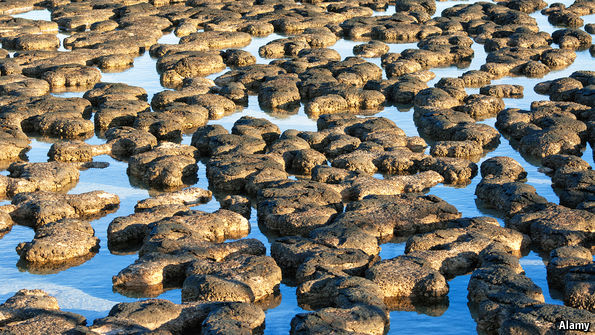Here is an article from the Economist. These tend to disappear from the Economist's web site after a few months so I have copied it onto the blog instead of just posting the link.
The ancient atmosphere
Time capsules
A new way to chart the rise of oxygen
OXYGEN makes up a fifth of the atmosphere (20.9%, to be precise), but that has not always been so. For the first 2 billion years of Earth’s existence, before photosynthetic organisms became common, there was no chemically uncombined oxygen in the air at all. Even after that, the gas remained scarce for hundreds of millions of years. By 575m years ago, however—which was when animals whose dimensions are measured in centimetres rather than microns appear—there must have been enough oxygen around to support their respiration. The usual guess is that the gas’s levels began to rise about 700m years ago. But a guess it is.
Now, Nigel Blamey of Brock University, in Ontario, Canada, has brought some evidence to bear on the question. His study, just published in Geology, is the first to measure directly the composition of samples of air from this ancient time. They were trapped in rock salt from the Officer Basin in south-western Australia, laid down by the evaporation of seawater between 830m and 800m years ago.
Previous estimates of oxygen’s past abundance have been made indirectly. In particular, the gas’s appearance in the atmosphere is dated to 2.5 billion years ago because that is when fossil stromatolites (small, rocky knolls built by photosynthesising bacteria; modern versions are pictured above), and also rocks called banded-iron formations, become common. Banded-iron formations, as their name suggests, are full of rust. Rust is formed by the reaction of iron with oxygen.
Dr Blamey thought he could do better than such indirect evidence. He chose rock salt (“halite”, to give its geological name) because its crystals often trap tiny pockets of the brine it is precipitating from, and this brine contains dissolved air. Such inclusions have been used to study the calcium, magnesium and potassium present in ancient seawater. Dr Blamey suspected they might also be employed to glimpse past atmospheres. The risk was that the composition of the trapped gas might change over the millennia. So he did a series of experiments to make sure that it does not.
First, he studied nitrogen, oxygen and argon concentrations in the cavities of modern halite, choosing crystals that had formed between two and seven years ago in New Mexico and Australia. The gas in these matched today’s atmosphere, so the actual process of trapping does not seem to affect its composition. Then Christophe Lecuyer, a colleague at the University of Lyon, in France, collected 6m-year-old halite from a mine in Sicily and 100m-year-old halite from a mine in Cretaceous rocks in China. The air in the Sicilian samples more or less matched modern air—which agrees with other evidence that the atmosphere has not changed a great deal in the past 6m years. The Chinese samples, by contrast, suggest oxygen made up 25.8% of the Cretaceous atmosphere. Again, this agrees with the palaeontological consensus, which is that the air the dinosaurs breathed contained more oxygen than does today’s.
Now convinced the method worked, Dr Blamey and his colleagues applied it to the Australian samples. These indicate that the air around when they were laid down was 10.9% oxygen. While this is only half modern values, it is five times more than predicted—suggesting the rise of oxygen to levels similar to today’s began a good deal earlier than had been believed.
This has implications for theories about the evolution of animals. The need to respire means abundant oxygen is a necessary precondition for large animals to come into existence. Many palaeontologists, however, have gone further, and seen it as a sufficient one. They think of unicellular creatures straining, as it were, on an evolutionary leash, waiting for there to be enough of the gas to support the big bodies multicellularity can create. Yet, though a few multicellular animals do predate 575m years ago, all those discovered so far are microscopic. It therefore looks as if sufficient oxygen was available to support big bodies for hundreds of million of years before evolution took advantage of it.
Why oxygen levels rose when they did is a separate question, and one Dr Blamey’s result does not address directly. But his method’s precision means that if other halite deposits of appropriate age can be found and tested, it might be possible to build a detailed graph of the gas’s rise—and that, in turn, may lead to explanations that currently elude the field’s practitioners.

No comments:
Post a Comment